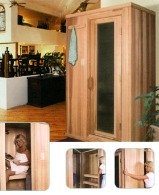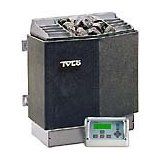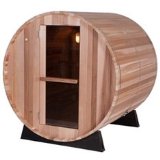Are Infrared Saunas Safe To Use?
If you’re considering investing in an infrared sauna for your home, you’re likely drawn in by claims of detoxification, stress relief, weight loss, and muscle recovery. But with these potential benefits comes a smart consumer question: Are infrared saunas actually safe—especially for frequent home use?
The short answer: Yes, infrared saunas are generally safe for most healthy adults when used correctly. But there’s more to it than that. Below, we’ll cover the science, potential risks, key buying considerations, and how to make safe use part of your long-term wellness plan.
What Exactly is An Infrared Sauna?
Unlike traditional saunas that heat the surrounding air to warm your body, infrared saunas use radiant heat—infrared light that penetrates the skin to raise your core temperature from the inside out. This allows for sweating and therapeutic heat exposure at lower ambient temperatures (typically 110°F to 140°F).
Key Differences:
- Lower temps = greater comfort, especially for heat-sensitive users
- Energy-efficient (lower wattage and faster warm-up)
- Uses far-infrared, mid-infrared, or near-infrared wavelengths—each penetrating the body differently
You can learn more about Far vs. Mid vs. Near Infrared Saunas here.
Scientific Research: Infrared Saunas Safety
Clinical Safety
Most studies conclude that infrared sauna use is safe and well-tolerated among healthy adults and even some with chronic conditions. A 2009 review published in Canadian Family Physician found no adverse side effects when used appropriately.
Far-infrared sauna therapy has been used in Japan for decades under “Waon therapy,” showing benefits for people with chronic heart failure and arterial disease. In these clinical settings, 15-minute sessions followed by rest and hydration were standard protocol.
Your heart rate increases mildly in an infrared sauna, simulating light-to-moderate exercise. This effect can improve blood vessel function, lower blood pressure, and support metabolic health. A long-term Finnish study found that people who used a sauna 4–7 times per week had:
- 50% lower risk of fatal heart disease
- 40% lower all-cause mortality
What About Detox? Fact vs. Hype
One of the most heavily marketed benefits of infrared saunas is “detoxification”—specifically, the idea that deep sweating can remove harmful toxins from the body such as heavy metals, BPA, and environmental pollutants.
But what does the research say?
The Role of Sweat in Toxin Removal Key Takeaway for Buyers
Several small but credible studies show that sweat does contain trace amounts of toxins, including:
- Heavy metals like lead, cadmium, mercury, and arsenic
- Persistent organic pollutants (POPs) such as PCBs and flame retardants
- Plasticizers like BPA and phthalates
For instance, a 2012 study published in the Journal of Environmental and Public Health found that both blood and sweat samples from participants showed detectable levels of arsenic, lead, mercury, and cadmium, and that sweating could aid in their excretion—especially when combined with other detox strategies.
Another study highlighted that BPA levels in sweat were often higher than in urine, suggesting that sweating could be a unique and valuable detox pathway, particularly for individuals with high exposure.
However, the amount of toxins removed through sweat is generally small relative to the body’s overall detox burden. Your liver, kidneys, and lymphatic system do the heavy lifting. Sweating complements their work—but should not be viewed as a replacement for healthy habits like good nutrition, hydration, and avoiding toxin exposure in the first place.
Infrared saunas may support detoxification, but they are not a silver bullet. Think of them as part of a bigger wellness strategy that includes diet, hydration, sleep, and environmental awareness. For people exposed to heavy metals in their occupation or environment—or those with sluggish detox systems—infrared saunas may offer an extra boost worth exploring with a healthcare provider.
Who Should Be Cautious When It Comes To Sauna Use?
While infrared saunas are safe for most people, some groups should avoid or consult a physician before use:
➤ Pregnant people
➤People with cardiovascular conditions
➤Those on certain medications
➤Children and older adults
Raising core body temperature in pregnancy can be risky.
While some heart conditions benefit from infrared therapy, others—like arrhythmias or low blood pressure—may not.
Diuretics, beta-blockers, and barbiturates can impair sweating or heat regulation.
They regulate heat less effectively and may overheat more easily.
Learn more about the Dangers of Infrared Saunas
Is EMF Exposure a Valid Concern?
Another hot topic among infrared sauna buyers is EMF (electromagnetic field) exposure. Since sauna heaters use electricity to produce infrared radiation, it’s natural to wonder whether the EMF levels they emit pose a health risk—especially with repeated, close-up exposure in an enclosed space.
What Are EMFs?
EMFs are energy fields emitted by all electronic devices, including your phone, microwave, and Wi-Fi router. They are measured in milligauss (mG), and levels below 3 mG are commonly considered low exposure by many holistic and environmental health practitioners.
There are two primary types of EMFs to be aware of in saunas:
- ELF (extremely low frequency) EMFs, often generated by heating elements and electrical wiring
- RF (radiofrequency) EMFs, sometimes emitted by Bluetooth or smart controls
Infrared Saunas and EMF Levels
Older and cheaper sauna models—especially budget imports or off-brand units—have been documented to emit high EMF levels, sometimes exceeding 20 mG in seating areas. But in response to consumer concern, many modern sauna brands now engineer their heaters and wiring systems to produce low or near-zero EMF emissions.
Trusted brands like Sunlighten, Clearlight and Heavenly Heat often advertise independently tested EMF levelsbelow 1–2 mG, and sometimes under 0.5 mG at typical seating positions. These brands often also design for low ELF and low VOC materials, appealing to chemically sensitive or EMF-aware users.
How to Choose a Low-EMF Sauna
- Look for published EMF test results from third-party labs
- Choose brands that label their units as “Low EMF” or “Ultra Low EMF”
- Avoid models with metal mesh heaters or poor electrical shielding
- Steer clear of any model that doesn't provide EMF ratings or uses vague language like “EMF-safe” without specifics
If you're highly sensitive or already dealing with health issues potentially linked to EMF (e.g., tinnitus, insomnia, chronic fatigue), a low-EMF sauna is essential.
Safe Home Use: Best Practices
To safely enjoy your home infrared sauna, follow these tips:
- Start with 10–15 minute sessions; increase gradually
- Use 2–4 times per week or as tolerated
- Always hydrate before, during, and after
- Avoid alcohol or heavy meals before sauna use
- Use towels to absorb sweat and avoid sitting directly on wood
- After your session, cool down slowly—wait 5–10 minutes before showering
- Never use while feeling unwell, dehydrated, or under the influence
Conclusion: So Are Infrared Saunas Safe?
Yes—infrared saunas are safe for most home users, especially when you choose a well-built, certified unit and follow reasonable use practices. When used responsibly, they offer:
- Cardiovascular support
- Muscle recovery
- Stress reduction
- Enhanced relaxation
- Supportive detoxification
They’re not magic boxes—but when integrated into a healthy lifestyle, they can be a powerful wellness ally.
Before buying, ask yourself:
- Does this model meet EMF and safety standards?
- Do I understand my own health risks?
- Am I prepared for safe installation and regular maintenance?
If the answer is yes, you’re ready to enjoy the restorative benefits of sauna therapy—right from your own home.






